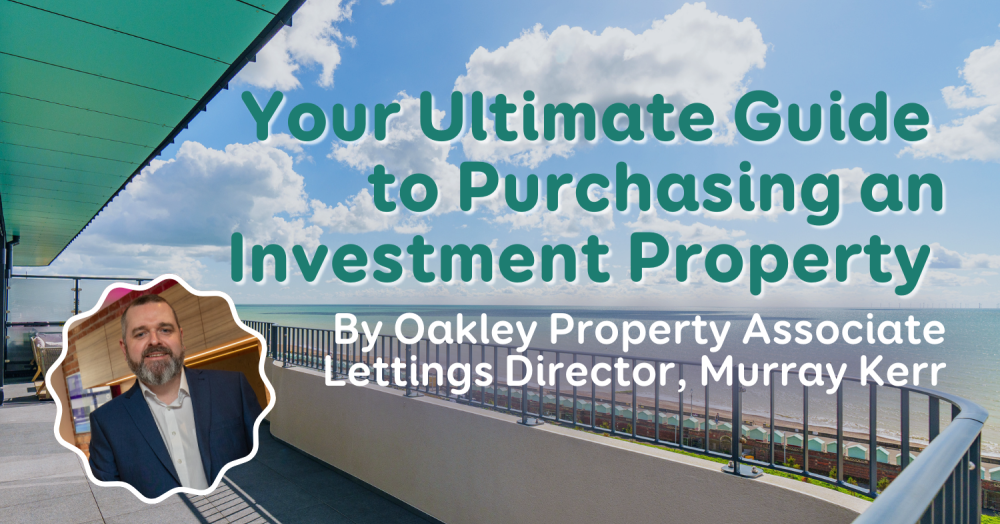
Your Ultimate Guide to Purchasing an Investment Property
Whether you want to be a great landlord or grow your wealth through property, investing in real estate remains a smart move. As you Sussex Property Experts, we know there’s a lot to consider before buying. That’s why we’ve put together these essential tips to help you make the right investment decisions.
Whether you’re looking to become a respected landlord among tenants or grow your money in a capital investment, property is still proving to be a fantastic way to grow your income and investments. As your Sussex Property Experts, we understand that there are plenty of things to consider before buying; we’ve curated these essential tips for anyone who is considering the purchase of a property for investment...
As with any property advice, each property and buy-to-let situation is different, so be sure to ask for specific advice before you get started. Agents can often spot an incredible opportunity from a mile off and guide you in the right direction.
This guide to purchasing an investment property provides valuable tips for anyone looking to make a sound real estate investment, whether for rental income or long-term capital appreciation. While this guide is an essential starting point, speaking to an expert will allow you to have a deeper understanding of your specific options. This comprehensive guide will explain the key facts you must consider before you make the decision:
Calculate Your Yield
In Sussex, rental yields can vary widely depending on the area. For example, Brighton & Hove typically sees higher yields due to strong tenant demand, particularly from students and young professionals, with over 4,200 shared houses in the city according to the 2024 Brighton & Hove Housing Strategy report. Areas like Eastbourne or Hastings may offer slightly better value in terms of purchase price, however the rental yield might not be as high. Be sure to research local rents in different Sussex towns to get an accurate idea of the potential return.
To calculate your rental yield, divide your annual rental income by the property value and then multiply it by 100 to get your yield percentage.
For example, if you bought a 2-bedroom flat in Brighton for £400,000, and you rented it out for £1600pcm, your yield would be 4.8%.
(£1600 x 12) ÷ £400,000 = 0.048
0.048 x 100 = 4.8%

Consider Capital Growth
Capital growth refers to the increase in value of a property overtime. It’s measured by the market value, which is determined by the local area, type of property and purchase price.
Sussex offers great potential for capital growth, especially in more urban areas such as Brighton, which has seen consistent price increases due to its popularity as a coastal city with excellent transport links. In Brighton and Hove, the average rent for flats has increased by 4.9% from January 2024. This is due to high demand for rental properties and a decline in the number of private rented properties. Areas like Crawley and Horsham may also experience steady growth, especially with ongoing infrastructure improvements and regeneration projects, as seen in East Sussex Hove Dairy in Hove Park and The Chalk Yard in Lewes. Research local trends to estimate how much value a property in Sussex could gain over the next few years.
Check for Demand
Demand for rental properties in Sussex is high, particularly in university towns like Brighton and Chichester, with rent prices increasing in the Southeast by 4.5% according to Zoopla rental market report from December of 2024. With easy access to London and beautiful coastal areas, these places attract professionals, students, and retirees. At Oakley Property, we can help you gauge demand and search for the specific type of property you're considering within Sussex.
Look for Convenience
Consider the accessibility of your property in Sussex. If you're investing in urban areas like Brighton, transport links to London are key for attracting tenants. Proximity to the coast, local shops, parks, and schools will make your property more attractive. In more rural areas, easy access to main roads or train stations can be a deciding factor for tenants.
Consider Your Target Market
Brighton & Hove is known for a diverse tenant pool, including students, professionals, and families, which helps keep rental demand strong. In smaller towns like Lewes or Bexhill, your property might attract retirees or families, so consider properties that can appeal to various demographics. Properties near universities, like in Brighton, will naturally attract student tenants, while coastal or semi-rural properties may appeal to those looking for a quieter lifestyle.
Avoid Major Downsides
Sussex has areas with varying environmental challenges. Be cautious of properties near noisy roads, such as those near major commuter routes or airport flight paths. Coastal properties can be affected by erosion or flooding risks, so check flood risk maps. Additionally, be mindful of properties with poor access in more rural areas, as tenants may be deterred if public transport is limited.
Estimate Your Cost of Maintenance and Repairs
Sussex properties, especially those in older towns like Chichester, Lewes or Arundel, may come with higher maintenance costs. Older buildings may require regular upkeep, particularly in terms of roofing, plumbing, and insulation. Make sure to account for these potential expenses when calculating your return on investment.
Factor in Fees
If you're investing in a leasehold property in Sussex, especially in popular areas like Brighton, be aware that there may be annual management fees and ground rents, which can affect your rental yield. Additionally, in coastal areas, you may need specialist insurance to cover flood risks or coastal erosion. Don't forget to factor in costs like property management fees, letting agency fees, and landlord insurance.
Minimise Voids
To minimise void periods in Sussex, you need to understand the local rental market and target tenants accordingly. In cities like Brighton, properties with good transport links or proximity to universities are likely to stay occupied. However, in more rural areas, tenant turnover may be slower, so it’s important to ensure your property meets local demand (e.g. apartments and family homes in town centres or attractive cottages in coastal villages). There are other options that are worth considering while your property sits empty, such as hosting on Airbnb as well as short term rentals, these come with their own logistics so be sure to do your research.
Check the Energy Performance Certificate (EPC)
As of 2025, all rental properties will need to meet the minimum energy efficiency standards, this means all rental properties will be required to have a minimum energy efficiency rating of C by 2030. Sussex has a mix of modern properties and older homes, and the latter may need investment in energy-efficient upgrades like insulation or new windows and heating. Be sure to check the EPC rating before buying, especially for properties in areas that may have older housing stock like in parts of Eastbourne or Chichester. There may be the option of help from a government scheme, for example the Great British Insulation Scheme aims of providing insulation for the least energy efficient households in the country.
With Sussex's mix of coastal, urban, and rural properties, understanding the specific local market is key to making a successful investment. If you’re looking to invest in a rental property, Oakley Property is your one-stop shop for all your property needs. We can provide high quality expert support from day one in your journey to becoming a landlord and ensure you get an investment that works for you.
What Next?
If you're still looking for your perfect buy-to-let investment, sign up to Oakley Property's Heads Up Alerts to receive property notifications before they appear on Rightmove and Zoopla.
Already found your investment? Don't hesitate to contact the Sussex Lettings Experts today! Contact our Lettings Team here.
